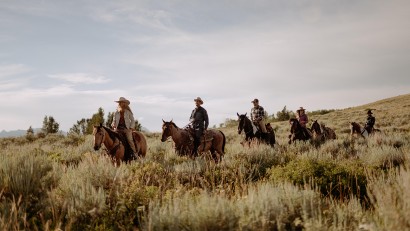- 1. Key Takeaways
- 2. Things to Consider Before Visiting Great Smoky Mountains National Park
- 2.1. How Many Days Do You Need to Spend in Great Smoky Mountains National Park?
- 2.2. Where to Stay in Great Smoky Mountains National Park
- 2.3. What to Wear When Visiting Great Smoky Mountains National Park
- 3. What to Do and See in Great Smoky Mountains National Park
- 3.1. Do the Cades Cove Scenic Loop
- 3.2. Explore Historical Landmarks
- 3.3. Abrams Falls
- 3.4. Clingmans Dome
- 3.5. Sample the Appalachian Trail
- 3.6. Grotto Falls - Walk Behind a Waterfall
- 3.7. Newfound Gap Road
- 3.8. Sugarlands Visitor Center
- 4. Final Thoughts
- 5. FAQs
- 5.1. Why should people visit the Great Smoky Mountains National Park?
- 5.2. What is the best time to visit the Smoky Mountains?
- 5.3. What are the dangers of the Great Smoky Mountains?
- 5.4. Can you swim in the Great Smoky Mountains National Park?
- 5.5. How long does it take to drive around the Smoky Mountains?
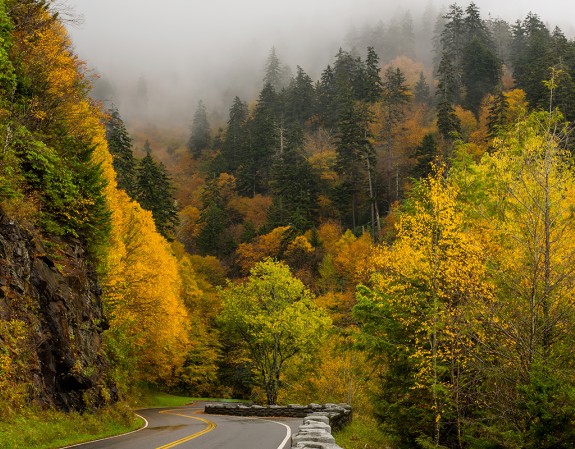
Things to Do in Great Smoky Mountains National Park
Table of Contents [Show]
The Great Smoky Mountains is America’s most visited national park. In 2023, the park welcomed a whopping 13.3 million visitors, nearly three times the number who visited the Grand Canyon.
One could attribute these big numbers to the park’s proximity to population. But Great Smoky Mountains National Park is a special territory in its own right. Hidden beneath its wispy, smoke-like fog is abundant wildlife ranging from black bears to salamanders, elk, coyotes, and white-tailed deer, among other local inhabitants. The Smokies is also a place to step back in time and experience the Southern Appalachian lifestyle of old, thanks to its collection of historic buildings from the 19th century.
Best of all, Great Smoky Mountains National Park offers pretty much everything that nature lovers want: camping, hiking, nature photography, scenic drives, fishing, whitewater rafting, horseback riding, you name it.
Get ready to be blown away by these 14 Great Smoky Mountains National Park things to do!
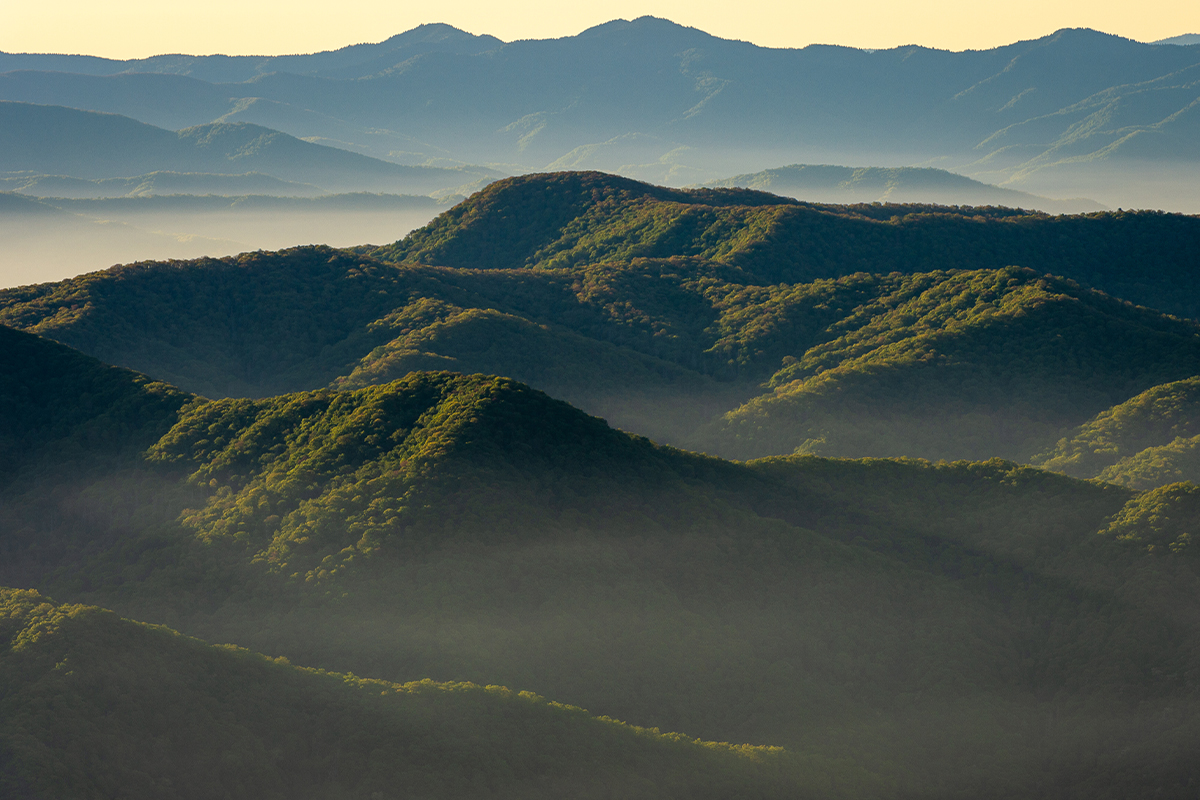
Key Takeaways
- LeConte Lodge is the only lodge inside Great Smoky Mountains National Park.
- If you prefer sleeping under the stars, consider Cades Cove, Stokemont, and Elmont campgrounds.
- You need at least three days to visit the Great Smoky Mountains' main attractions.
- Spring is the best time for a vacation in the Smokies.
Things to Consider Before Visiting Great Smoky Mountains National Park
Great Smoky Mountains National Park is in the southeastern part of the U.S. It straddles the border between Tennessee and North Carolina and covers 522,427 acres. There are six entrances to the Smokies.
The park's main entrances are Sugarlands at Gatlinburg, TN and Oconaluftee at Cherokee, NC. Oconaluftee is pronounced OH-kah-nuh-luhf-tee.
Townsend, TN, 25 miles west of Gatlinburg, is a quieter alternative to Sugarlands. It’s also the best for accessing the Cades Cove area, one of the top places to visit in the Smoky Mountains.
Other entrances to the park are:
- Cosby, TN
- Wears Valley, TN
- Cataloochee, NC
The closest airport to Great Smoky Mountains National Park on the Tennessee side is McGee-Tyson Airport (TYS). It’s located in Alcoa, TN, about one hour from the Sugarlands entrance. On the North Carolina side, Asheville Regional Airport is the closest airport to the Smokies. It’s about an hour’s drive from the Cherokee entrance.
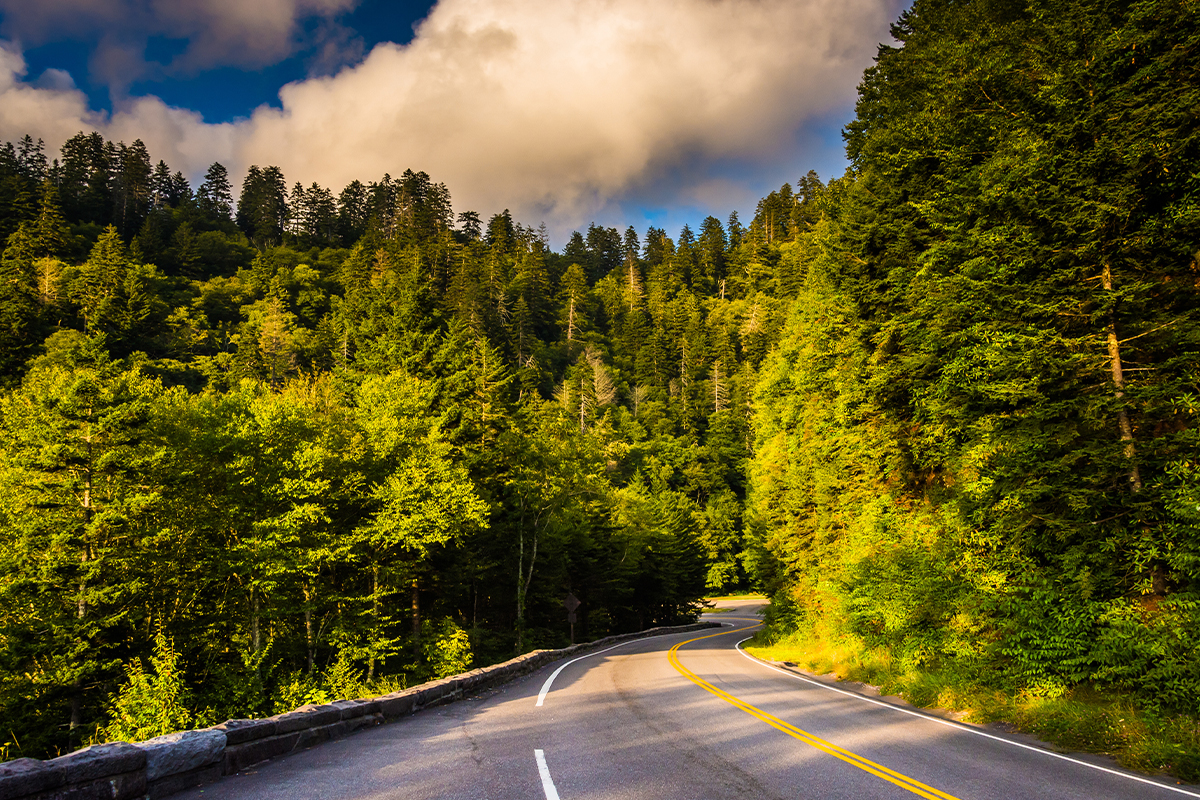
How Many Days Do You Need to Spend in Great Smoky Mountains National Park?
We recommend spending at least three days to get a taste of the Great Smoky Mountains attractions. If you have more time, you could spend one week in the Smokies and still leave looking forward to your next visit.
We’ve heard of outdoor lovers who have been going there for 50+ years and haven’t covered everything yet. That’s easy to believe considering this park’s riches, including 348 hiking trails, 16 breathtaking scenic drives, 10+ lakes, 100+ waterfalls and cascades and many more.
Can I see the Great Smoky Mountains National Park in one day?
A one-day visit is not enough to scratch the surface of all the things to do in the Smoky Mountains. But it’s still worth it, especially considering this park’s easy accessibility.
To maximize your time when visiting Great Smoky Mountains National Park for a day, we’d recommend focusing on the popular Cades Cove area.
One day at Cades Cove is enough to drive or pedal the scenic Cades Cove Loop Road, hike to Abrams Falls, explore historical sites like John Oliver Cabin, and look for wildlife. If you still have more time left, consider driving some of Newfound Gap Road.
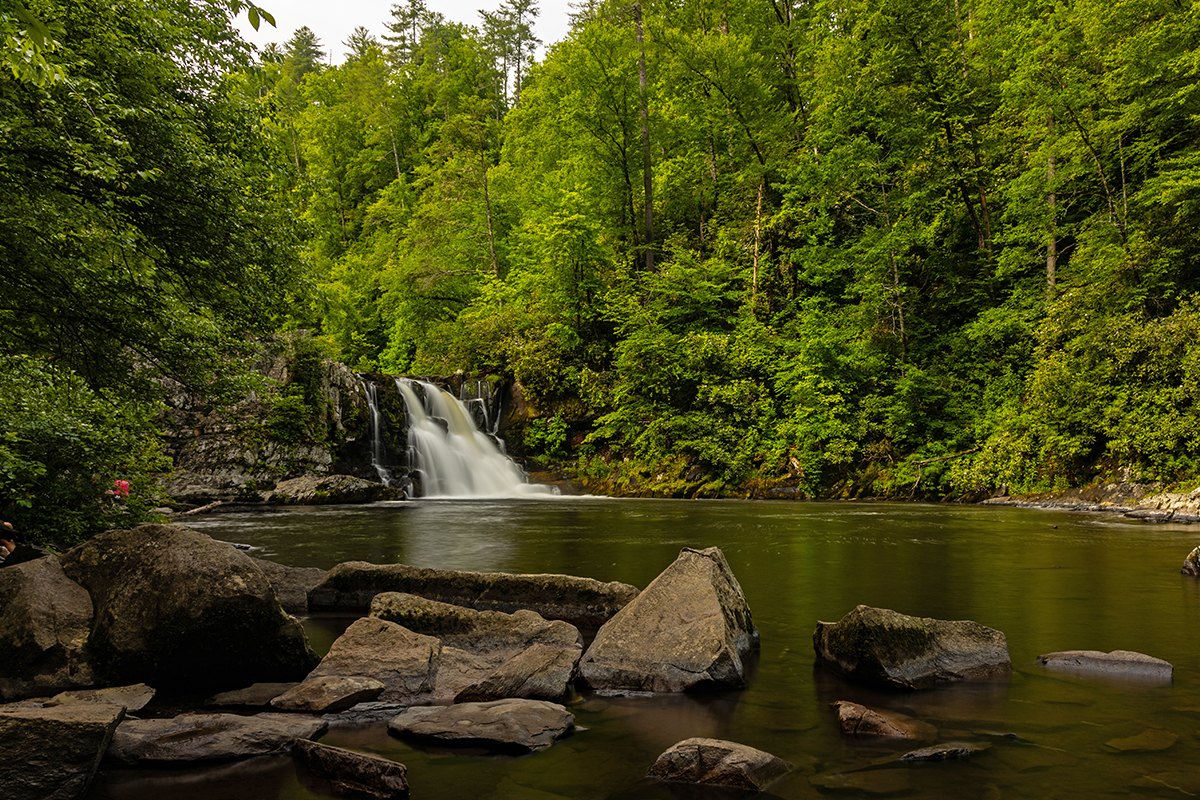
Where to Stay in Great Smoky Mountains National Park
Cabins/Lodges
LeConte Lodge is the only place to stay inside Great Smoky Mountains National Park besides camping. It is a charming collection of cabins, small lodges, and a dining room at the top of Mount LeConte, the Smokies' third-highest peak at 6593 feet.
LeConte Lodge caters to hikers and outdoor enthusiasts looking for a completely different accommodation. Part of its charm is that it is accessible only on foot. Six trails, ranging from five to eight miles, lead to the lodge.
To add to its rustic vibe, LeConte Lodge has no electricity or running water. The only lights are headlamps, flashlights, and kerosene lamps. What it offers is solitude and unparalleled views for days.
LeConte Lodge is open from mid-March to mid-November. Reservations are made via a lottery system. They are not hard to get, especially if you don’t mind the spring or fall timeframe for your Smoky Mountains vacation.
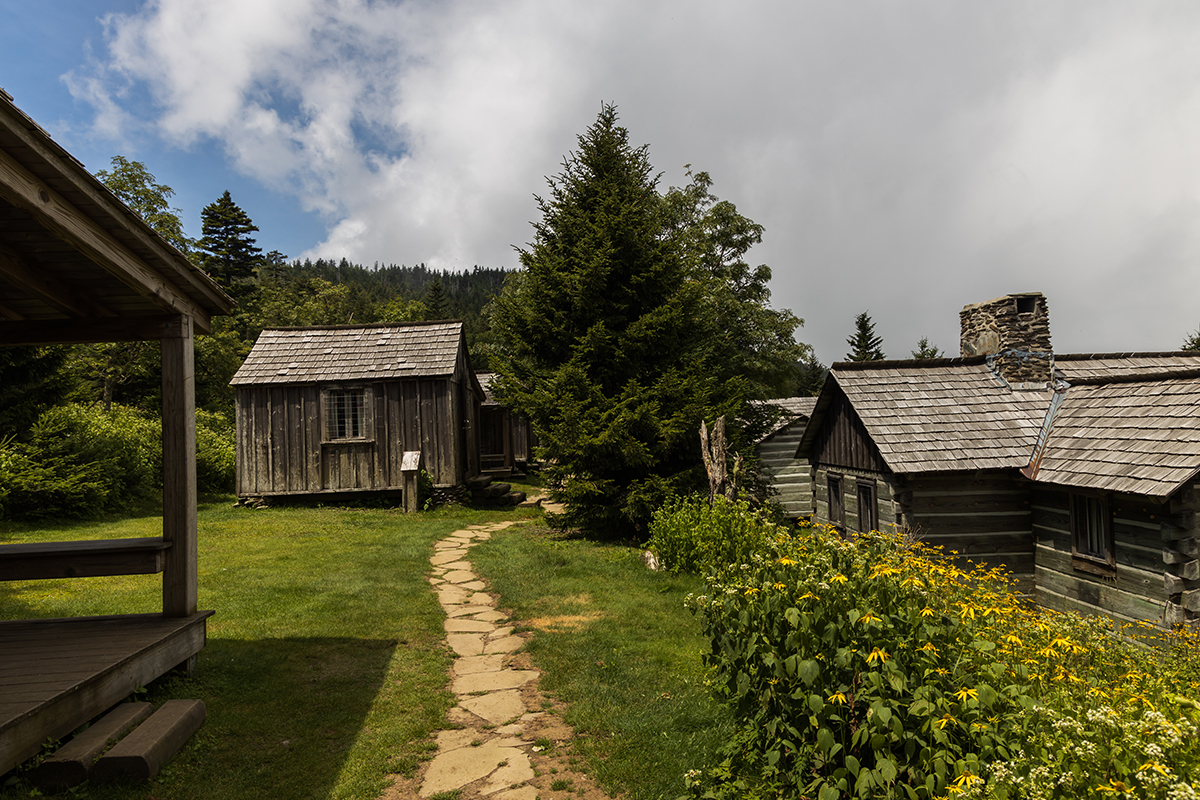
Campgrounds
Great Smoky Mountains National Park has ten campgrounds, all great places to sleep under the stars. However, for your first visit, we’d recommend staying in a campground off the main park roads. These are:
- Cades Cove Campground along Cades Cove Loop Road
- Elkmont Campground near U.S 441
- Smokemont Campground along Newfound Gap Road
Staying in these campgrounds means you can easily access most of the best things to do in the Smoky Mountains without much backtracking.
All Great Smoky Mountains National Park campgrounds have running water and flush toilets. There are no showers and electric/water hookups. There are 5-amp outlets at Cades Cove, Elkmont, and Smokemont campgrounds, but these are meant for campers with medical needs.
All Great Smoky Mountains campgrounds require advance reservations. There are no first-come, first-served sites. The camping fee per night ranges between $17.50 and $25.
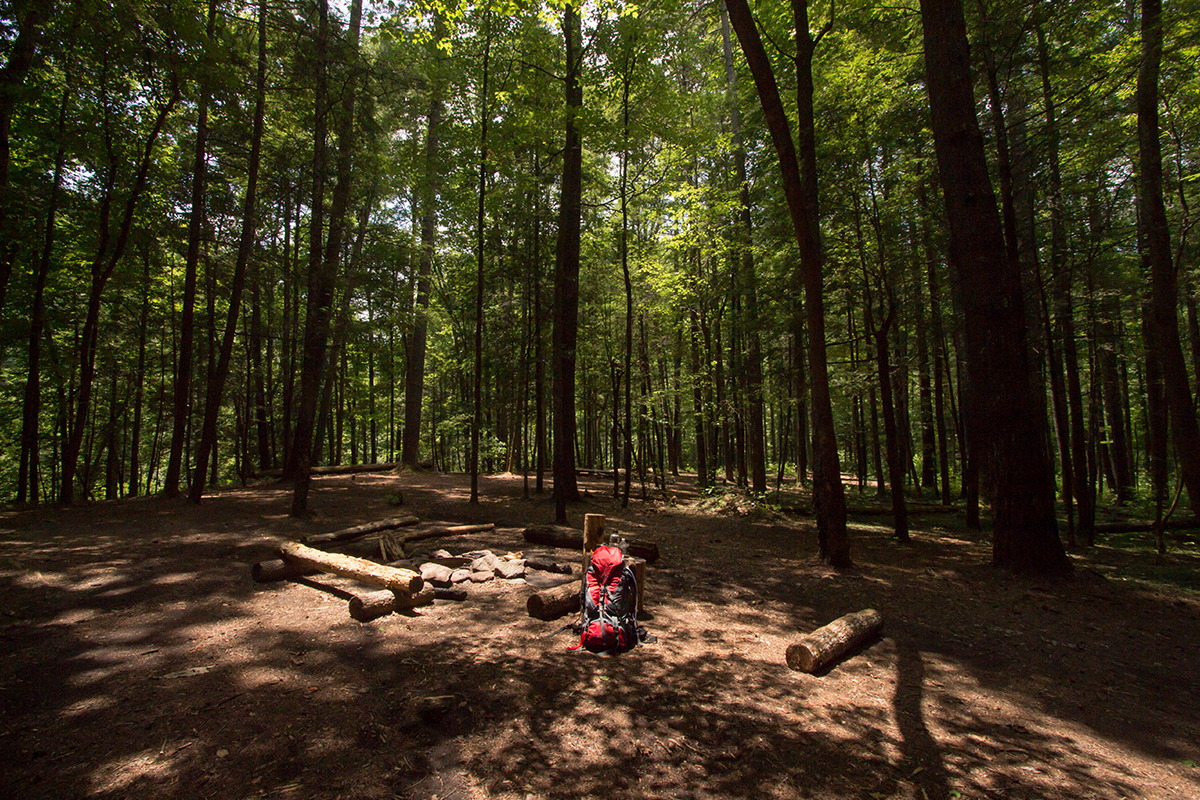
Towns near Great Smoky Mountains National Park
If you don't snag in-park accommodation, you will have plenty of lodging options outside the park’s entrances. For your first visit, we recommend Gatlinburg, TN. It offers a million things to do near Smoky Mountains National Park and an impressive collection of everything you need, including restaurants, gift shops, and cafes. Plus, the Gatlinburg entrance puts you in the center of all the best things to do in the Smoky Mountains.
Pigeon Forge is another excellent place to stay near the Smokies. This mountain resort city packs attractions for kids around every corner, making it a hit when visiting the Great Smoky Mountains National Park with children. Pigeon Forge puts you eight miles (one way) from the Sugarlands Entrance at Gatlinburg.
Townsend, TN and Cherokee, NC, are other great places to stay when visiting Great Smoky Mountains National Park. These two are smaller than Gatlinburg and Pigeon Forge, which makes for a much quieter experience.
What to Wear When Visiting Great Smoky Mountains National Park
Great Smoky Mountains National Park has a temperate climate, but it can get pretty chilly at its higher elevations, which range from 876 to 6,643 feet.
Regardless of when you visit, it’s a good idea to pack layers that you can easily add or remove to stay comfortable as temperatures fluctuate. For Spring and Summer, pack moisture-wicking shorts and pants, comfortable jeans, t-shirts, and long-sleeve shirts.
For a Fall vacation, your camping and backpacking checklist should be geared toward warmer clothing options, including heavier coats, gloves, and hats. (Don’t forget your first aid checklist, either!)
Browse through Kuhl’s collection of women’s hiking clothing and men’s outdoor wear specifically made for mountain hiking.
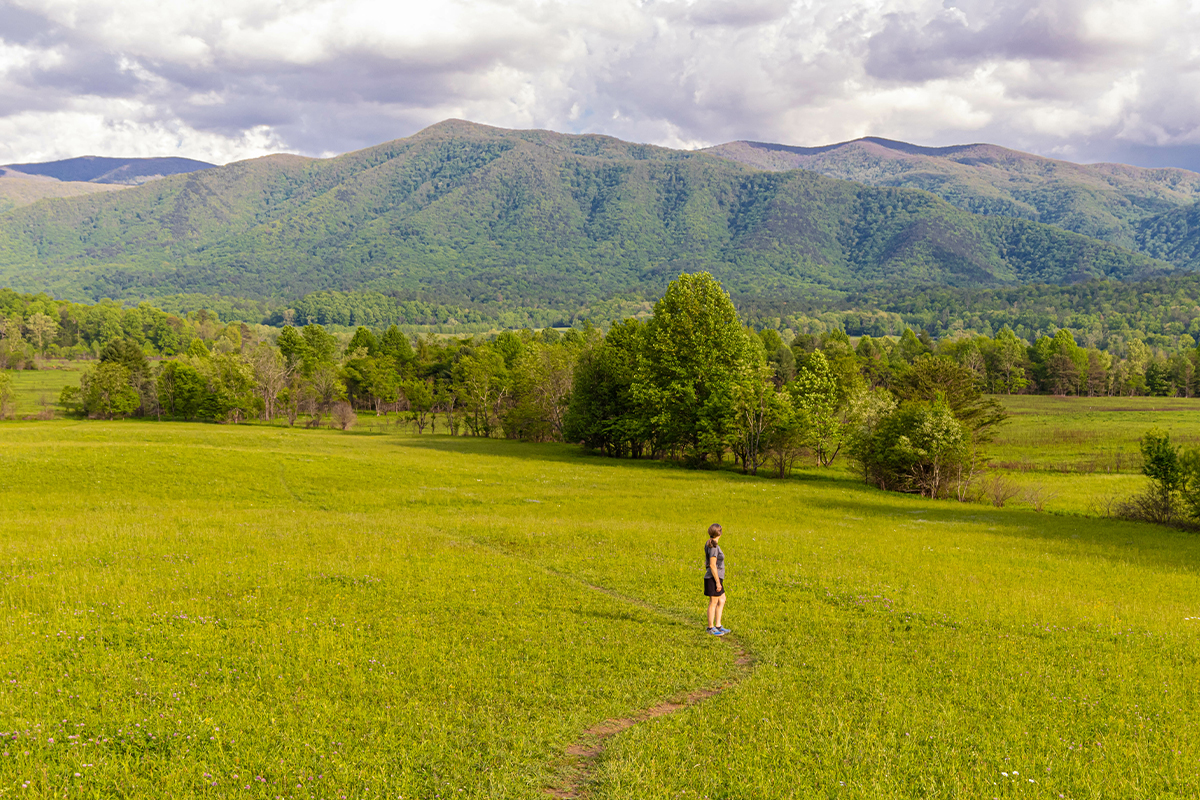
What to Do and See in Great Smoky Mountains National Park
Do the Cades Cove Scenic Loop
The Cades Cove Scenic Loop is one of the most popular things to do in Smoky Mountains National Park. It offers so much and is easily accessible.
Cades Cove is an incredible meadow surrounded by towering mountains. Besides its sweeping views, the valley is also a hotspot for wildlife. While you probably won’t see all of them, you have a high chance of spotting black bears, white-tailed deer, coyotes, raccoons, and turkeys.
The Cades Cove area is also home to many settlements and buildings established by the first European settlers in the 1800s (more on this below). Not to mention, Cades Cove boasts some of the best Great Smoky Mountains National Park trails, like Abrams Fall and Rich Mountain Loop.
The Cades Cove Loop, a one-way, 11-mile road, takes 2-4 hours to complete but may take longer depending on traffic. Of course, you’ll want to allow more time if you plan to hit some of the trails. This loop is free and opens from 8 AM to sunset year-round. All Wednesdays from May through September are vehicle-free days.
Explore Historical Landmarks
A definite highlight of what to do in the Smoky Mountains National Park is exploring its historical sites. Long before becoming a tourist attraction, the Smokies hosted a thriving community with schools, churches, and ranches. The vast majority of these unique historical sites are at Cades Cove.
Here are a few to include in your first Smoky Mountains sightseeing tour:
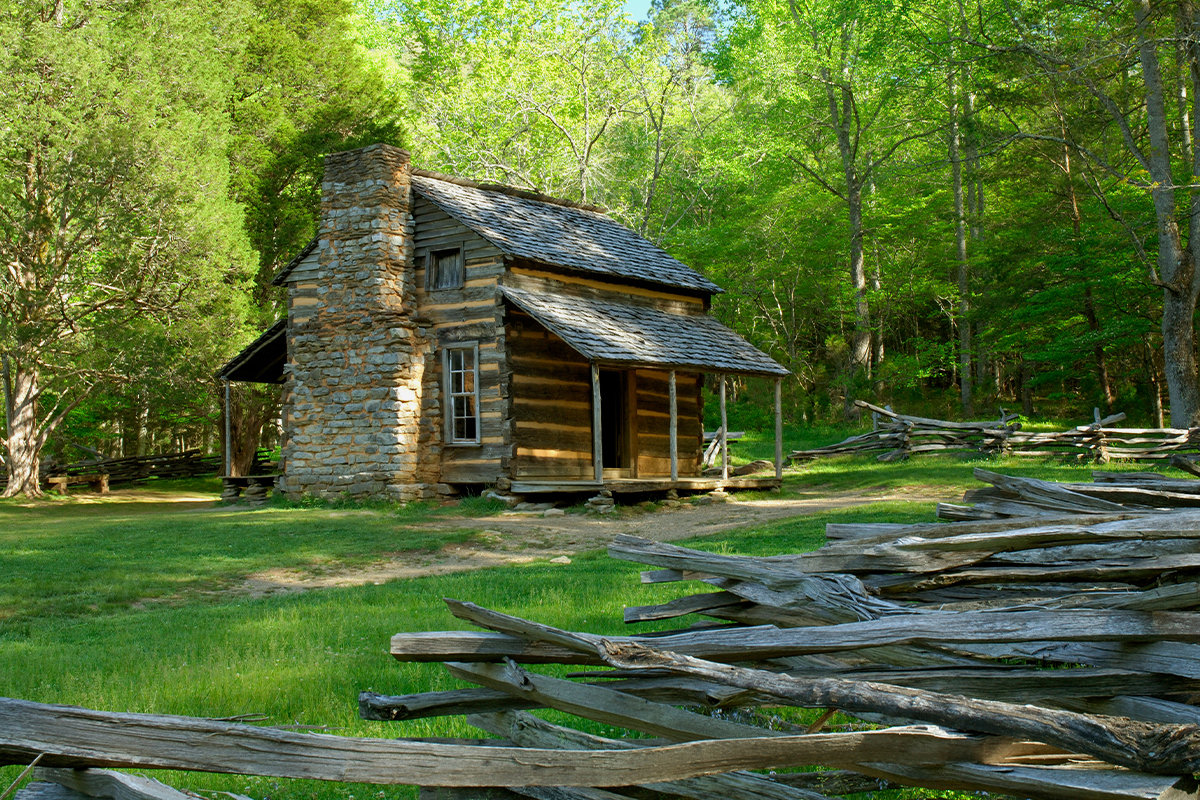
John Oliver Cabin
Built between 1818 and 1823, this is the oldest human structure in the Smokies. A cool fact about the cabin is that it has no nails or pegs. Instead, the Olivers used notching, which was a standard building technique during their times. A self-guided tour of its two levels gives insight into how families lived in the 1800s.
The John Cable Grist Mill
One of the best places to visit in the Smoky Mountains, the John Cable Grist Mill gives you a glimpse into Cade Cove’s milling history and 19th-century technology. The two-story structure has a creek-powered mill that the Cades Cove community used to grind wheat and corn into baking flour. Visit mid-week from March to October and weekends in November to see if it works.
The John Cable Grist Mill is just one of the many mills scattered around the Smokies. Others include:
- Mingus Mill - a half-mile north of the Oconaluftee Visitor Center
- Ogle Mill - a quarter-mile walk from Noah Bud Ogle Cabin on Cherokee Orchard Road
- Regan Mill - located along Roaring Fork Road just outside Gatlinburg

Primitive Baptist Church and Cemetery
Visiting Primitive Baptist Church is essential when exploring Cades Cove Loop Road attractions. Built in 1887 after a split from the original church, the Primitive Baptist Church lets you in on the religious history of the Cades Cove community and life after the Civil War. The cemetery behind the church is the resting place for the early settlers, including the Cables, Olivers, Gregorys, and Shieldses.
Abrams Falls
While in the Cades Cove area, check out Abrams Falls. It’s among the most popular waterfall hikes and unique places to see in the Smoky Mountains.
Abrams Falls in Cades Cove is a short five-mile out-and-back hike. But it has its fair share of elevation changes, meaning it’s not as easy as you think. Still, if it's a moderately difficult hike that you’re looking forward to, this is it.
Abrams Falls stands only 20 feet high. However, it has abundant rushing water, which makes it one of the most voluminous and impressive in the park. The large pool at its base is a great place to cool off your feet after the hike, but it’s not a safe spot for swimming due to its undertow.
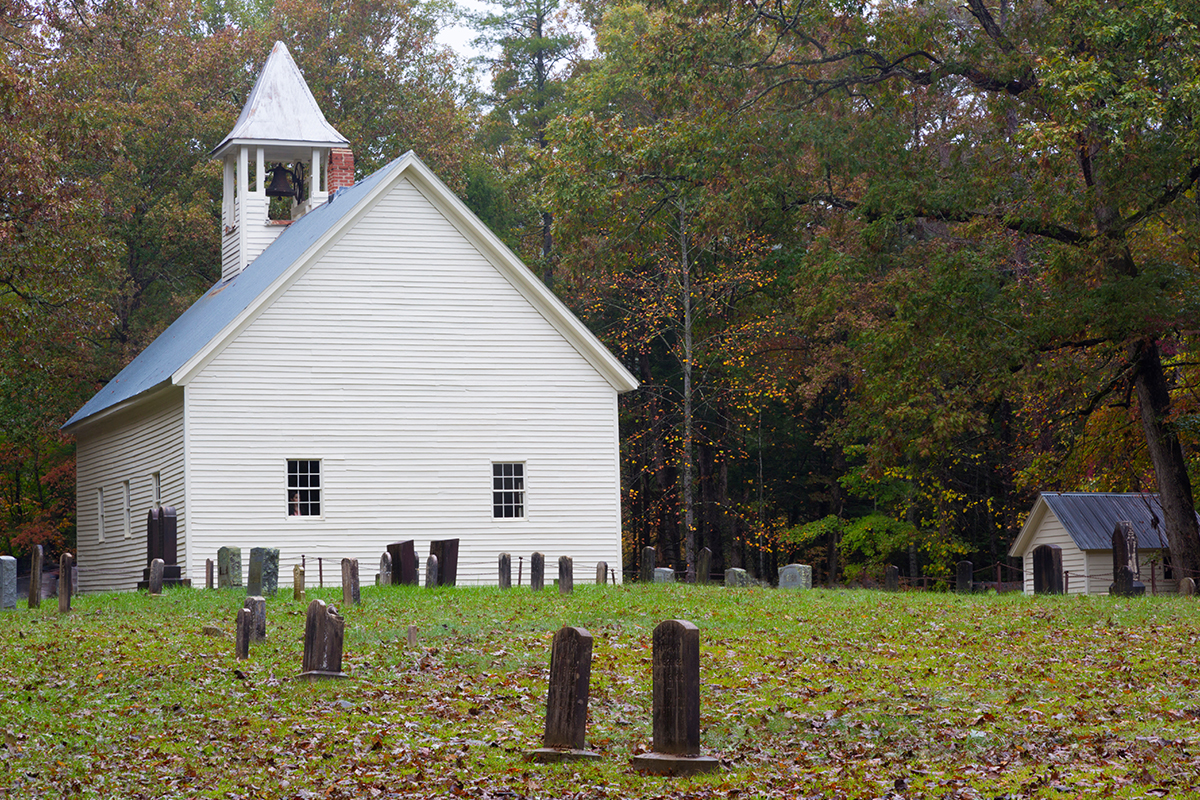
Clingmans Dome
Visiting Clingmans Dome should top your itinerary of things to do in the Great Smoky Mountains National Park. At 6,643 feet above sea level, Clingmans Dome is the highest peak in the Smokies. It's popular for its observation tower, which offers the best views of the Smoky Mountains, including valleys, forests, and rivers. Views can go as far as 100 miles on clear days!
Clingmans Dome is best accessed via the Sugarlands Entrance near Gatlinburg. From Gatlinburg, drive south on Highway 441/Newfound Gap Road for about 16 miles. Turn right onto Clingmans Dome Road and drive 7.3 miles to the parking area. From the parking lot, hike the 0.5-mile trail to the observation tower. It’s steep, but the views at the top justify the effort.
Sample the Appalachian Trail
The Appalachian Trail is one of the best hikes in the U.S. It holds another title: it’s the longest hiking-only footpath in the world, stretching 2,190+ miles from Maine to Georgia!
You may be surprised to learn that the Appalachian Trail runs across the Smokies for about 72 miles. Most trekkers complete this section in about a week. But if you don’t have that much time, you can sample this world-famous trail by hiking from Newfound Gap to Clingmans Dome observation tower.
The 14.9-mile out-and-back hike takes 9-10 hours to complete. But you can also do it as a one-way hike by having a vehicle waiting for you on the other end of the trail.

Grotto Falls - Walk Behind a Waterfall
Grotto Falls is unique in a national park packed with waterfalls because you can walk behind it! This is one of the best things to do in Great Smoky Mountains National Park, especially when visiting with kids.
Grotto Falls Parking is 5.8 miles or a 30-minute drive from Gatlinburg via Cherokee Orchard Road and Roaring Fork Road. From the parking lot, the trail to Grotto Falls (called Trillium Gap Trail) is 2.6 miles round-trip. It gains close to 600 feet of elevation and takes 2-3 hours to complete.
Arrive early in the morning to secure a parking spot near the trailhead. Otherwise, you may have to park pretty far down the road and walk uphill to the trailhead.
Newfound Gap Road
The Newfound Gap Road is one of our favorite Great Smoky Mountains National Park attractions. There are 16 breathtaking drives in the Smokies, but you’ll definitely want to make the time for this one!
The Newfound Gap Road connects you to most of the top things to do in the North Carolina and Tennessee sides of the Great Smoky. Running for 33 miles from Gatlinburg, TN, to Cherokee, NC, you’ll love this road because it lets you experience all that the park has to offer in about an hour. By this, we mean you’ll be treated to different forests, gorgeous views, historical sites, and two visitor centers.
Some of our Smoky Mountains must-see spots along this scenic road are:
- Sugarlands Visitor Center
- Carlos C. Campbell Overlook
- Chimney Tops Overlook
- Ben Morton Overlook
- Newfound Gap (where President Franklin D. Roosevelt dedicated the park in 1940)
- Charles A Webb Overlook
- Mingus Mill
- Oconaluftee Visitor Center
- Museum of the Cherokee People in Cherokee
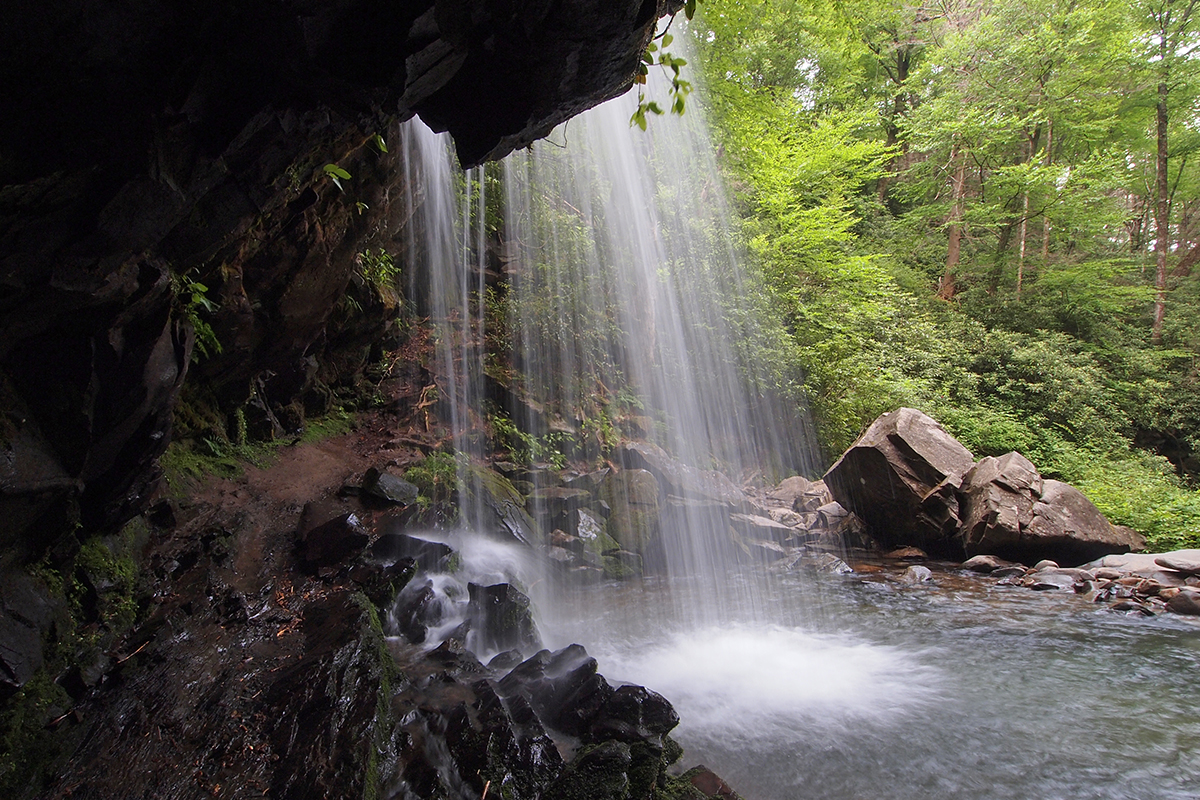
Sugarlands Visitor Center
Sugarlands Visitor Center is one of those Smoky Mountains tourist attractions that you just have to hit on your first visit. The visitor center has a backcountry permits office where you can pick up the necessary permits for camping or hiking in remote areas.
You'll also find natural exhibits and watch a 20-minute movie, both of which offer a nice introduction to the Smokies. Sugarlands Visitor Center is also home to a fun museum and a gift shop.
For more free things to do in the Smoky Mountains, there are several trails around this visitor center:
Cataract Falls Trail
An easy 1.1-mile (round-trip) hike that leads to a 25-foot waterfall. Great for kids and visitors with limited mobility.
Fighting Creek Nature Trail
An easy and handicap-accessible nature trail that winds through multiple historic cabins. Fighting Creek Nature Trail in Great Smoky Mountains National Park is a 1.2-mile long easy loop.
Old Sugarlands Trail
A moderately challenging 7.5-mile (round-trip) forest trek packed with history and wildlife. This is a low-traffic trail, which is surprising considering its convenient location.
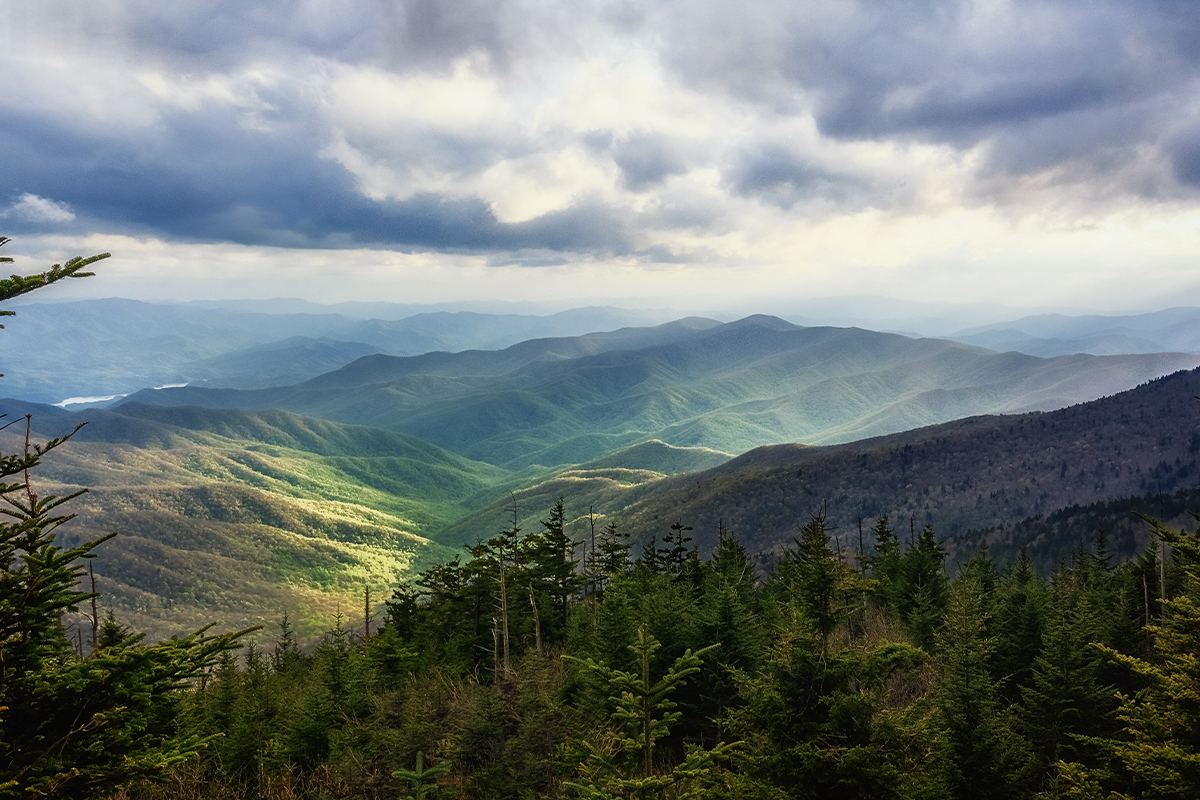
Final Thoughts
There you have it — the 14 Smoky Mountains National Park things to do! The Smokies is a true gem that all outdoor enthusiasts should experience at least once. Whether you’re a history buff, a nature lover, or an adventure seeker, Great Smoky Mountains National Park promises an enchanting experience that will leave you craving for more! Have more time to spare? After hitting your target Great Smoky National Park attractions, use Tennessee or North Carolina as a jumping-off point to other East Coast National Parks, like Acadia, Biscayne National Park, and Hot Springs National Park.
Featured image, Newfound Gap Road in Great Smoky Mountains National Park by: Larryknupp.
FAQs
Why should people visit the Great Smoky Mountains National Park?
Nearly 12 million visitors visit the Smokies annually to tune in to nature, get up close and personal with wildlife, and experience the fascinating history of the early European settlers.
What is the best time to visit the Smoky Mountains?
Spring is the best time to visit the Smokies when the weather is pleasant, the crowds are fewer, and the flowers are blooming.
What are the dangers of the Great Smoky Mountains?
The major dangers to beware of in the Smokies are hypothermia, drowning, medical incidents, dehydration, and motor vehicle accidents.
Can you swim in the Great Smoky Mountains National Park?
Absolutely! The Smokies have more than ten swimming pools where you can take a dip. Our favorites include:
- The Sinks - located on Little River Road near Townsend
- The Wye (pronounced Y) - the largest and most popular swimming hole in the Grand Smoky Mountains near Townsend.
- Midnight Hole - located in the Big Creek area on Big Creek Trail
How long does it take to drive around the Smoky Mountains?
There are about 384 miles of roadway and 16 scenic drives in the Smokies. Most roads are paved, while the graveled ones are well maintained to accommodate standard passenger cars. It’s possible to drive through all these roads in just a day, assuming you don’t make any stops. But it’s best to set aside 2-3 days of excursion if you want to see all that the scenic drives have to offer. Trust us, there’s A LOT!
Here are five Smoky Mountains scenic drives that are a must-do:
- Cades Cove (11 miles, paved)
- Newfound Gap Road (33 miles, paved)
- Little River Road (18 miles, paved)
- Roaring Fork Motor Trail (5.5 miles, paved)
- Foothills Parkway (33 miles, paved)


